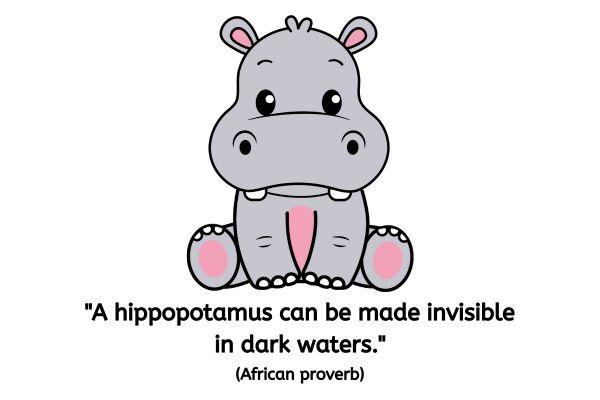What Does An Invisible Hippopotamus Have To Do With Coaching?

Today’s quote is a proverb:
“A hippopotamus can be made invisible in dark waters.” (African proverb)
It seems like basic common sense that if you are in the habitat of a dangerous wild animal, then it is wise to be aware and respectful of their potential presence. I have a healthy respect for hippopotamus’ but I’m no expert, so for me, it was how this proverb could also apply to coaching that prompted me to write this post.
This ancient saying resonates deeply with the essence of coaching, for me, as it offers insights into the unseen aspects of human experience. While it may initially evoke images of the dangers lurking in ignorance of one’s physical surroundings, it also holds a profound metaphorical meaning for our coaching practice.
I interpret this proverb as a metaphor for the hidden forces that influence our thoughts, emotions, and behaviours. Just as a hippopotamus vanishes beneath the surface of dark waters, so too can our deepest fears, insecurities, and potential remain concealed from view. In coaching, we often uncover hidden beliefs and thinking; when clients have an insight and suddenly recognize thoughts or beliefs they hadn’t consciously acknowledged before. These insights can profoundly and immediately impact their behaviour and perspective.
In coaching, we often embark on journeys to uncover these hidden aspects of ourselves and our clients. We navigate the murky depths of the mind, shedding light on the shadows that lurk within. Through open dialogue and introspection, we assist our clients in exploring these unseen forces, guiding them towards greater self-awareness and understanding.
However, the resonance of this proverb extends beyond its literal interpretation. It speaks to the power of perception and the illusion of reality. Like the hippopotamus fading into obscurity in the darkness, our perceived problems and limitations can dissolve when viewed through the lens of understanding.
As coaches, we help our clients see beyond the surface appearances of their circumstances. We invite them to delve beneath the waves of their thoughts and emotions, uncovering the deeper truths that lie hidden beneath. By illuminating the unseen forces at play, we empower our clients to navigate the waters of change with clarity and confidence.
But how do we make the invisible visible? How do we guide our clients in seeing beyond the surface of their experiences? It begins with a shift in perspective—a willingness to look beyond the superficial and embrace a deeper understanding of reality. As coaches, we serve as guides, illuminating the path ahead and helping our clients discern the unseen forces that shape their lives.
Through deep listening, compassionate inquiry, and our own understanding, we create a safe space for exploration and discovery. We encourage our clients to trust in their intuition and wisdom, guiding them towards insights and breakthroughs that lead to profound transformation.
In conclusion, the proverb “A hippopotamus can be made invisible in dark waters” offers a poignant reminder of the unseen forces that shape our lives. As coaches, we have the privilege of shedding light on these hidden truths, guiding our clients towards greater self-awareness and understanding. By embracing the unseen depths of coaching, we empower our clients to navigate the waters of change with clarity, confidence, and courage.
I’m curious, presuming that you read the title of this post before the actual content – what answers did you have in your head about what could possibly be a connection between invisible hippopotamus’ and coaching? Feel free to drop any thoughts in a comment below.
About Jen Waller

Jen Waller is on a mission to support, nurture and encourage coaching skills and talents from non-coach to coach and beyond.
As an experienced coach and trainer, Jen is happy to utilise all skills at her disposal to assist clients from getting out of their own way and making a difference in the world with their coaching. Find out more about the support Jen offers here.








